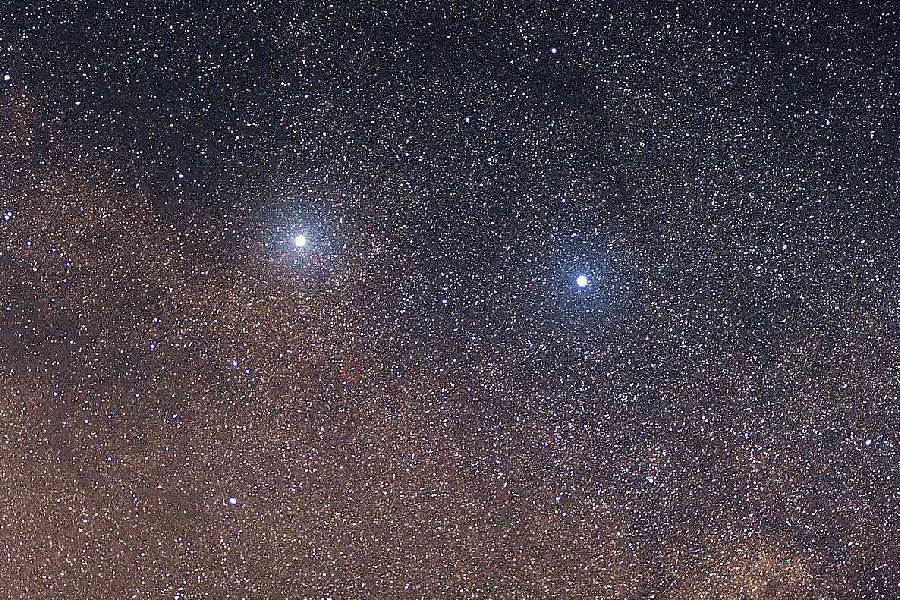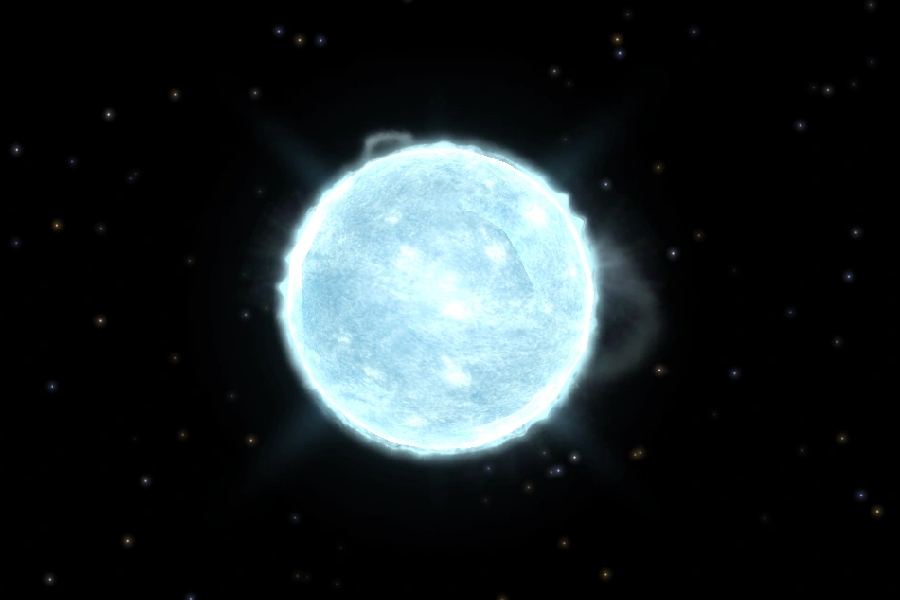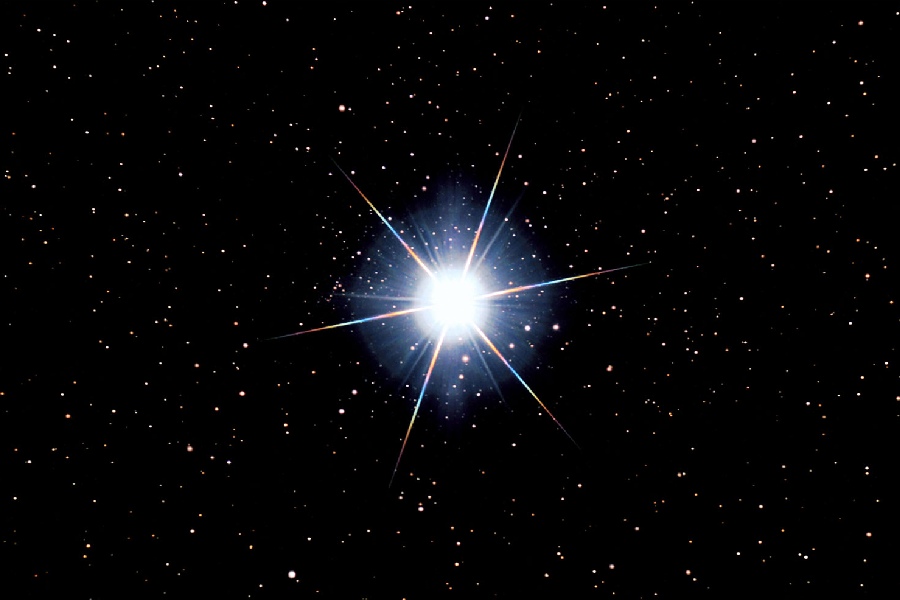Since ancient eras, bright stars have sparked wonder when darkness blankets the night sky in specks of light spanning horizon to horizon. But which cosmic titans blaze the most brilliantly from Earth’s view? What are the brightest stars in the sky?
Throughout the year, the stars we see change because constellations move across the sky depending on the season and where we are on Earth. So, a variety of first-magnitude stars may claim the title of “brightest star visible” on any given night.
What qualities establish the pecking order of the top 20 observable stars? A star’s apparent and absolute magnitude, along with its distance, reveals why some stars shine brighter than others.
In this article, we’ll dive into the night sky and discover the most luminous stars out there. We’ll explore what makes them shine so brightly and how we measure their brightness.

What Are the Brightest Stars in the Sky?
The brightest stars in the sky are celestial objects that emit substantial light and are easily visible from Earth. These stars outshine others due to their proximity, size, or intrinsic luminosity.
Prominent examples include Sirius, the brightest star in the night sky, and Canopus, the second brightest. Their brilliance makes them notable navigational and observational points in the night sky, contributing to the rich tapestry of celestial wonders.
Sirius – The brightest star in the night sky
Sirius, the famed Dog Star, holds the title of brightest star in Earth’s night sky. This brilliant blue-white object frequently twinkles with immense radiance over shadows. Located a mere 8.6 light-years away in the Canis Major dwarf galaxy, dazzling Sirius never escapes notice.
Sirius owes its brilliance to several key factors, including its proximity to Earth, massive heat generation as an A1V spectral type, and high luminosity. Among the nearest stars to our Sun, Sirius A outshines all except the rare few visible that occasionally surpass it.
The vivid stellar gem captivates skywatchers worldwide with its flashy presence and intriguing mythology.
Canopus – The next in line
The second-brightest star has as an ally different metrics determining its glow. White giant Canopus, although more intrinsically luminous than Sirius, lies over 300 lightyears distant in the Carina constellation.
This F0Ib supergiant resides amid the nearest star clusters illuminating southern hemisphere skies. With a far greater mass and size than Sirius despite its vast distance, brilliant Canopus radiates equivalent brightness as an astonishing 15,000 suns.
Among all surrounding stars, only extragalactic supernova 1987A has temporarily outshone this stellar colossus over recent years in absolute magnitude. Impressively bright Canopus comes closest to matching Sirius levels of standout radiance visible in Earth skies through sheer power.
Alpha Centauri – A triple-star system
Alpha Centauri is one of the closest star systems visible in our sky. This multiple system gravitationally binds the stars Alpha Centauri A, B, and Proxima Centauri within five light years in the Milky Way galaxy. Together they present a unique opportunity for astronomical study.
Of its members, Alpha Centauri A shines brightest as a Sun-like star. Alpha Centauri B orbits closely as a slightly cooler orange dwarf. Tiny red dwarf Proxima Centauri dances far at the system’s edge. Their proximity intrigues efforts to understand if orbiting worlds could resemble Earth.
Betelgeuse – The red supergiant
Betelgeuse is a red supergiant star located over 600 lightyears away in the Milky Way galaxy. This aging star has dramatically dimmed recently to two-thirds its peak brightness. Significant opacity and pulsation changes have challenged prediction models for its behavior.
Betelgeuse’s intriguing instability has fueled speculation on imminent supernova potential. One day, it promises an unrivaled stellar spectacle, likely detonating across Orion for awed earthly viewers. Will we soon witness Betelgeuse’s spectacular finale lighting up the night sky?

Vega – A blue-white luminary
Vega amazes as the brightest star in Lyra and fifth overall highest on brightness ranking lists. Lying 25 lightyears away in the Milky Way galaxy, this blazing blue spectral A0V-type star illuminates northern summer and autumn skies as a guidepost for many.
Vega sets northern hemisphere latitudes aglow on July and August nights in particular. Its brilliant white gleam accompanies the start of annual Perseid meteor showers originating from Swift-Tuttle comet debris in the Vegan vicinity.
Rigel – Blue supergiant in Orion
The sixth-brightest nighttime star, Rigel, anchors the constellation Orion unmistakably through colder months. Located nearly 1,000 lightyears away in the Milky Way, this blue supergiant shines 120,000 times brighter than our Sun. Among visible stars, only Canopus surpasses Rigel’s intrinsic luminosity.
Its icy blue gleam forms an eastern seasonal beacon as part of Orion’s signature belt, fully prominent by January. Rigel was named by ancient observers, meaning “foot”; today, stargazers worldwide appreciate this sparkling gem marking the mythical Hunter’s left knee.
Antares – The heart of Scorpius
Fiery red supergiant Antares emblazons the Scorpius’s heart with its unmistakable ruddy signature. Over 500 lightyears away in the Milky Way, Antares impresses with a diameter rivaling Mars‘ orbit! Its enormous size and illumination earn Antares its name meaning “Rival of Mars”.
Antares steals attention amid orange-hued companions while anchoring Scorpius. When the constellation peaks in June/July, blazing crimson Antares dramatically stands apart from surrounding lights.
How We Measure Star Brightness in the Night Sky
Astronomers use special tools and techniques to measure star brightness. They rely on the magnitude scale, photometry, and spectrometry methods. These quantify the light output from stars.
Measurement tools
The magnitude scale assigns brightness numbers to celestial objects. It goes from negative values for the very brightest down to high positive numbers for the dimmest. Zero represents a mid-point reference level.
Photometry uses sensitive electronic detectors to capture and compare starlight. This data feeds calculations determining standard magnitude measures for scoring brightness.
Spectrometry spreads a star’s light into signature energy patterns, revealing properties like temperature and composition. All combined insights refine star brightness models. Modern digital tracking mounts move telescopes. This allows long-exposure photography to record faint, deep sky splendors.
New technologies like CCD imaging continue improving analysis. Detailed observation also fuels the discovery of brightness variability over time in some stars. Multiple methods scientifically indicate the most luminous observable stars visible in Earth’s night skies across seasons.

Conclusion
We hope learning about some of the most dazzling stars in our celestial sphere has inspired you to keep looking up at the night sky. Understanding the science of star brightness and constellations and how to locate heavenly bodies are just the beginning steps on the journey to becoming skilled at astronomy.
This article has provided foundational knowledge for identifying the brightest stars in the sky. It has also fueled curiosity to continue discovering the wonders of our universe through both telescopes and binoculars, as well as unassisted eyes transmitting starlight to our awed senses.
As you learn to identify Orion’s Belt or locate blazing Sirius, remember countless curious minds have gazed up and questioned the stars’ mysteries over history.
Let this shared human experience of marveling at the heavens fuel your own stargazing, sparking personal meaning as you connect with the timeless cosmic spectacle above.
